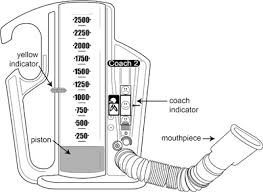Respiratory Volumes & Capacities
Published (updated: ).

Spirometry is the most common type of pulmonary function or breathing test. Spirometry is used to determine a given patient’s lung volumes and capacities as the test measures how much air one can breathe in and out of their lungs. Ambulances do not carry such devices. Discussing lung capacities for EMS personnel is complete hypothetical.
Lung Volumes and Capacities
Different animals exhibit different lung capacities based on their activities. For example, cheetahs have evolved a much higher lung capacity than humans in order to provide oxygen to all the muscles in the body, allowing them to run very fast. Elephants also have a high lung capacity due to their large body and their need to take up oxygen in accordance with their body size.
Human lung size is determined by genetics, gender, and height. At maximal capacity, an average lung can hold almost six liters of air; however, lungs do not usually operate at maximal capacity. Air in the lungs is measured in terms of lung volumes and lung capacities. Volume measures the amount of air for one function (such as inhalation or exhalation) and capacity is any two or more volumes (for example, how much can be inhaled from the end of a maximal exhalation).
Lung Volumes
Tidal volume (TV) measures the amount of air that is inspired and expired during a normal breath. On average, this volume is around one-half liter, which is a little less than the capacity of a 20-ounce drink bottle.
Minute respiratory volume is the tidal volume multiplied by breaths per minute. This would give the clinician insight to the amount of air being moved in and out of the patients lungs on a minute basis. If it were determined that the the minute volume is too low to be compatible with human life, artificial ventilation would be initiated.

Lung Capacities
The lung capacities are measurements of two or more volumes. The vital capacity (VC) measures the maximum amount of air that can be inhaled or exhaled during a respiratory cycle. It is the sum of the expiratory reserve volume, tidal volume, and inspiratory reserve volume. The inspiratory capacity (IC) is the amount of air that can be inhaled after the end of a normal expiration. It is, therefore, the sum of the tidal volume and inspiratory reserve volume. The functional residual capacity (FRC) includes the expiratory reserve volume and the residual volume. The FRC measures the amount of additional air that can be exhaled after a normal exhalation. The total lung capacity (TLC) is a measurement of the total amount of air that the lung can hold. It is the sum of the residual volume, expiratory reserve volume, tidal volume, and inspiratory reserve volume..
